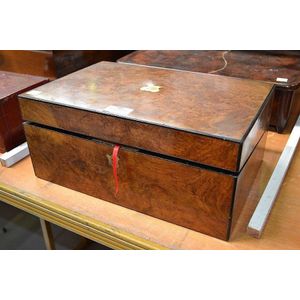Art Deco Birds Eye Maple Console with Shelf
You must be a subscriber, and be logged in to view price and dealer details.
Subscribe Now to view actual auction price for this item
When you subscribe, you have the option of setting the currency in which to display prices to $Au, $US, $NZ or Stg.
- Maple - Maple, native to North America, is a dense heavy timber from light to yellow-brown in colour. It has very little distincive graining unless it is one of the variants such as birds-eye maple or burr maple, so was not used extensively for furniture in 18th and 19th century, where cabinetmakers and designers preferred timbers with more distinctive features such as mahogany, walnut, rosewood and oak.
Birds-eye maple has a seres of small spots linked by undulating lines in the grain, is highly sough and is used as a decorative veneer. Burr maple has larger and irregular grain swirls than birds-eye maple. - Art Deco Period - The Art Deco period was a cultural movement that emerged in the 1920s and 1930s, and was characterized by its emphasis on modernism, luxury, and elegance. The name "Art Deco" comes from the Exposition Internationale des Arts Décoratifs et Industriels Modernes, a large exhibition held in Paris in 1925 that showcased the latest trends in decorative arts.
Art Deco was a reaction against the ornate and elaborate styles of the previous era, and reflected a new modern sensibility. It was characterized by streamlined, geometric shapes, bright colours, and the use of new materials such as chrome, glass, and Bakelite. Art Deco designers sought to create a sense of luxury and sophistication, often incorporating expensive materials such as ivory, marble, and rare woods.
Art Deco had a significant impact on a wide range of artistic fields, including architecture, fashion, graphic design, and interior design. Some of the most iconic examples of Art Deco architecture include the Empire State Building in New York City, the Hoover Building in London, and the Palais de Chaillot in Paris.
The Art Deco period came to an end in the 1940s, as World War II and changing cultural trends led to a shift in artistic styles. However, Art Deco remains an important influence on design and art, and continues to be celebrated for its modernist sensibility and glamorous aesthetic. - Bird's Eye Maple - Bird's eye maple is a type of wood that is characterized by its unique, small, round eyes or spots that are scattered throughout the wood. These spots are caused by a genetic defect in the tree, and they give the wood a distinctive, swirling pattern that is highly sought after by woodworkers and furniture makers.
Bird's eye maple is harvested from the hard maple tree, which is native to Northern Europe and North America. The wood is generally pale in colour, with shades of cream, white, or light brown. The bird's eye figure is most seen in hard maple, but it can also be found in other species of maple such as the big leaf maple and silver maple, but hard maple is the most common.
It became fashionable in furniture manufacturing for use as a decorative veneer from the late 18th century to the late 19th century.
As well as furniture making, it is also used in musical instruments such as guitar, drums, and pianos and smaller decorative items such as various type of boxes such as tea caddies and in picture frames.
This item has been included into following indexes:
Visually similar items

Antique walnut and brass writing slope, approx 15 cm

A Federation Tasmanian oak tray mobile, with drop-sides on metal casters 74 cm high, 100 cm wide, 82 cm deep

17th century Spanish walnut provincial chair of small proportions, with a rectangular top rail carved in light relief with a central floral emblem framed by ornate scroll work above the waist rail and solid seat, raised on square legs joined by straight

George III oak coffer, 115 cm wide, 51 cm deep, 60 cm high
